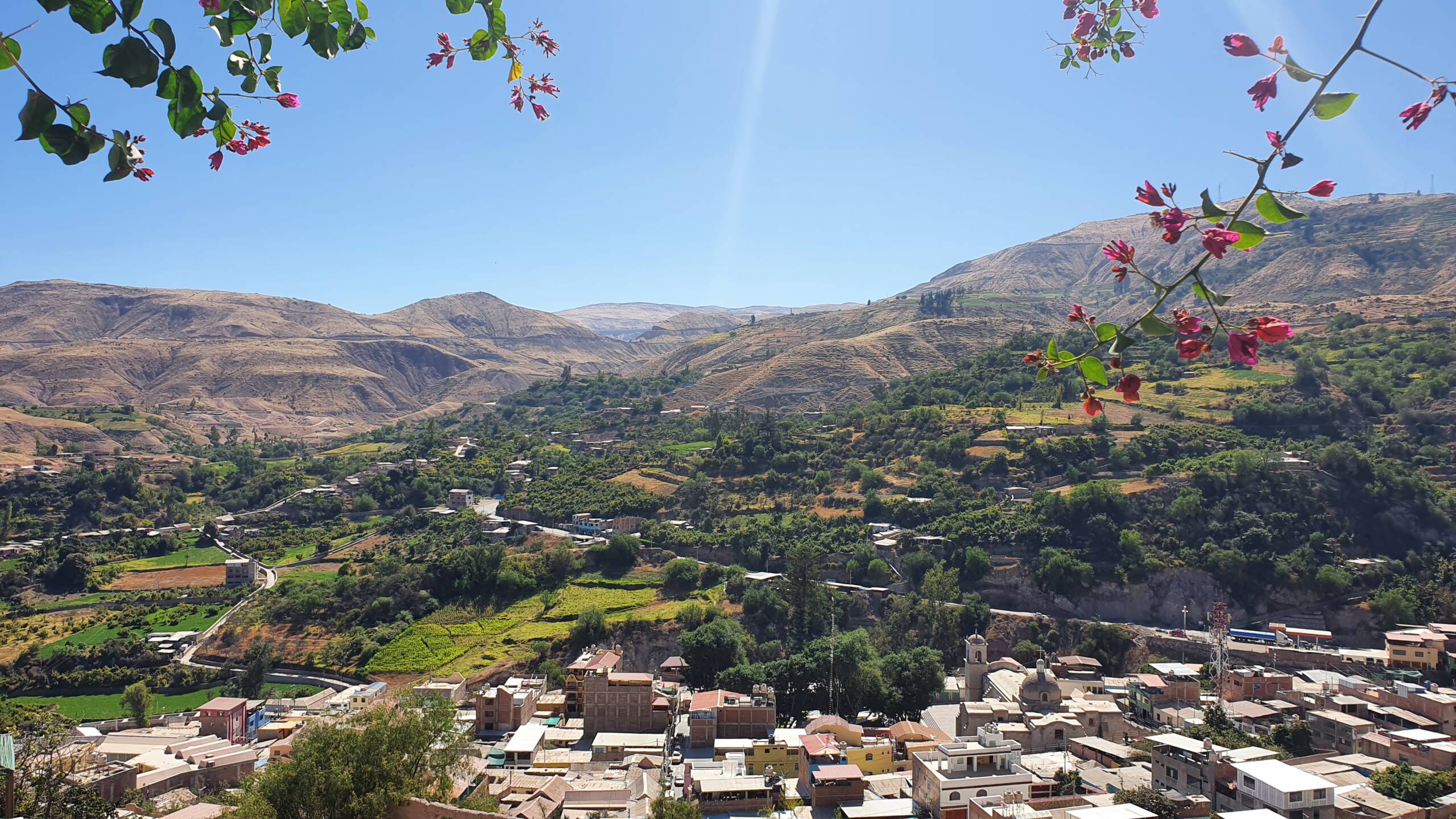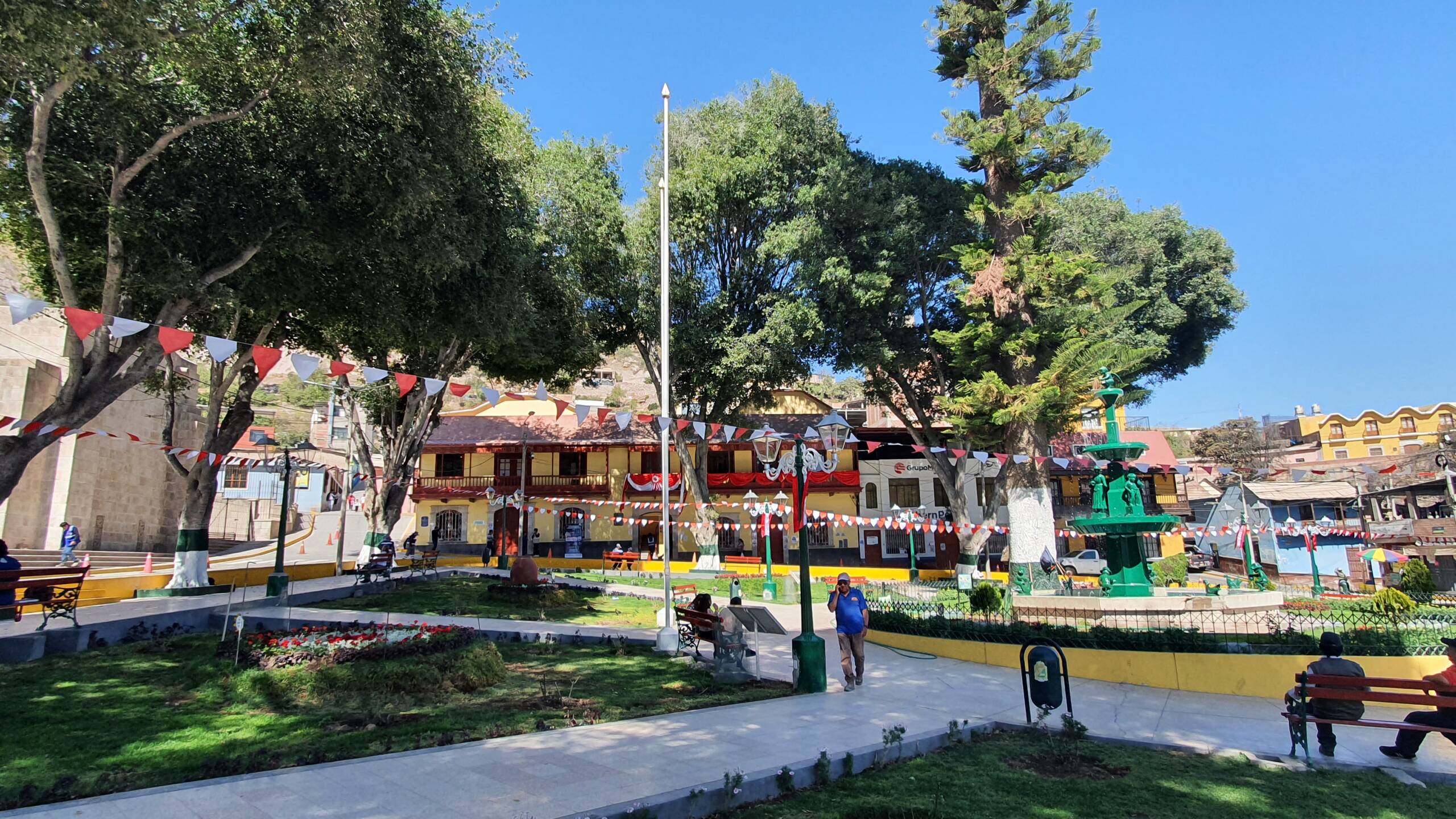Torata is a village of around 2,000 inhabitants, located on the valley of its namesake river, some 2,300 metres above sea level and 20 miles upstream from the town of Moquegua; in the heart, therefore, of the Western Andean Range, whose peaks are the gate to the Peruvian altiplano, which some 250 miles farther to the northwest is finally walled by the Eastern Range, or the Andes proper as we know them from illustrations and films. Behind these, but many thousand foot lower, lies the immense Amazonian basin.
As the traveller approaches the village, on one of the many hills along the winding road he will read, in huge letters made of whitewashed heaped stones, this text: “TORATA CRECE GRACIAS AL CANON MINERO” (Torata grows thanks to the mining canon); which immediately provokes in me two somehow mutually inseparable reflections: a) What for needs Torata to grow?, and b) Does it mean that, in the name and in exchange for the sacrosanct growth, its inhabitants must rejoice for the mining industry to gradually pollute their valley until denuding it of the very charm precisely thanks to which Torata is still such an idyllic place to live? Rhetorical questions, obviously.
The long-standing dogma of growth is a sophism that hasn’t ever been explained and has never resulted -that I know of- in any better self well-being (the only welfare that really matters) for the members of the to-grow society. One would think that those who unquestioningly believe in that dogma (i.e., almost everybody) are somehow subjected to the influence of the divine command of Genesis 1:28 or suffer from a Darwinian misinterpretation regarding the life of societies, which either grow or else are doomed to perish (or be absorbed by other, more “prosperous” ones); but I think this is wrong because, if the dilemma every society faces were to be “to grow or to die out”, I see no reason why the same principle could not be applied also to any other animal or vegetable population, in whose case there would be no living species on the planet in balance with their habitat; which is not the case.
However it be, and biblical or evolutionary considerations aside, human societies have lived for tens of thousands of years (up until -so to say- yesterday) without any growth criteria or objective whatsoever, in stationary equilibrium, and in most cases they have not gone extinct or anything terrible has happened to them. The modern doctrine of “growth per se” is completely artificial, not at all necessary or inevitable, and I wouldn’t be surprised if it turned out to be a consequence of the industrial revolution or even some more ancient event, such as the invention of money. But what do I know about those topics? What I do know with elementary prescience is that, thanks to mining and “growth”, in a few decades Torata will be an unrecognizable mud pit and will have lost its happy Arcady as sure as I lost my grandma.
The “mining canon” referred to here is the economic compensation that, in Peru, municipalities affected by mining receive; and its very existence clearly reveals the pernicious effects of this type of industry on public health and the environment (among other factors), because if mining were entirely harmless (or even beneficial!, as the people of Torata are told), why would they need to be indemnified?
The Cuajone copper mine is located four miles from Torata, up the valley as the crow flies. It is the largest of its kind in the country and has been exploited for more than half a century by the Southern Peru Copper Corporation, an originally American business that was acquired in 2005 (90% of the shares) by the Mexican stock company Grupo México. Cuajone is a huge 8 miles long open pit monster that, along with the purely extractive works, includes a mineral pre-processing plant, both of which activities have over the years led to various complaints and protests by peasants in the municipality because of river contamination and other problems. On the other hand, a detailed study indicates that the mining canon and royalties, whose theoretical justification is both “to consolidate the growth of economic sectors alternative to mining” and “to improve the quality of life of the inhabitants of the Torata district”, are not leading to achieving the objectives pursued, since on the one hand the municipal budget depends 98% on said transfers (that is, there is no longer an economic sector alternative to mining, and were it not for the canon, Torata would already have disappeared) and, on the other hand, neither the GDP per capita, nor the life expectancy nor the educational level in the town have improved to an appreciable extent with respect to the period immediately prior to the implementation of the compensations. In other words, these have not been drivers of well-being.
Which, of course, does not really imply any failure regarding the compensations’ true objective, which is no other than to silence, with money, the region’s inhabitants. Always the same old story. Short-term remedies, garish and useless as glass beads but in keeping with human nature, myopic for everything that is not immediate. Although–why should it be otherwise? No animal is endowed with the instinct necessary to prevent and prepare for the future.
The village consists of five streets skirting the north slope of the narrow valley in which it sits and another four, very steep, perpendicular to those. At its highest point (so much so that the 200 metres’ ascent from the plaza leaves the visitor, when reaching the top, panting and shaky-legged) there is a viewpoint with a huge White Christ from which can be contemplated in all their beauty the small lowlands and fields shelterd by the valley, and above which, on the opposite slope and in heavy contrast with the greenery, the brownish and barren mountains of the sierras stretch out in the distance.
Seeing Torata like this from above, embedded in an oasis of green (and despite the irremediable ugliness of its tin roofs), it is difficult not to think of a little piece of paradise. But this vision is a little misleading, since we are not talking about a hamlet lost in the mountains and populated by a dozen old women plus a few goatherds, but rather a village with a not entirely insignificant activity: in and around the lovely and shady plaza, where most of the local life takes place, people keep passing, on foot or wheels, on their way to their chores; there are a dozen eateries and as many shops, a police station and a beautiful neoclassical church not too old. There is also at least one school in the municipality, not short of pupils, and even a sports center with a football field. On the outskirts, half a dozen construction sites endorse the “growth” the Government speaks of. And yet, Torata’s atmosphere is of great tranquility, the neighbors welcome the strangers and no one seems to be in much of a hurry. From time to time a wrinkled native woman, skin like old leather, slowly walks up a steep street, dressed in motley clothes of absurd colors interspersed with sequins, stuffed in wool despite the strong midday sun, a feathered felt cap on and carrying on her back the mysterious, ever-present Incan bundle wrapped in polychrome striped cloth; or she sits on a park bench, expressionless yet sort of smiling (perhaps the effect of her marked cheekbones and the grooves at the corners of her eyes?), motionless and as though she had absolutely nothing else to do in life.
The place is, without a doubt, very enticing and invites staying a couple of nights. But as turns out, there is no accommodation available: the five newly-refurbushed/built properties featuring rental rooms (w/wo furniture) only offer them for months, not for days. As one of the landladies tells me, it’s because the cleaning maids charge 30 soles; but this explanation doesn’t seem quite plausible to me, because, even if she charged only 40 soles for a room, a traveler who wanted to stay for–say–three days would earn her 90 soles net, which is better than nothing. I would rather think that these people have made a strong investment with the mine workers in mind, and cater only for them because their long stays yield the landlords good and stable monthly income without needing to bother with occasional travellers who, like yours truly, are looking for peace havens.
Too bad Torata is doomed to disappear all the same! If the copper seam does not reach the village’s subsoil–in which case it will be evacuated and tore down in order to continue extracting mineral–sooner or later the mine will run out, the royalties will be cut short and then it’ll be time to die; sorry about the environmental devastation. But in the meantime, sure!, everything is going great and “we grow thanks to the mining canon”.



